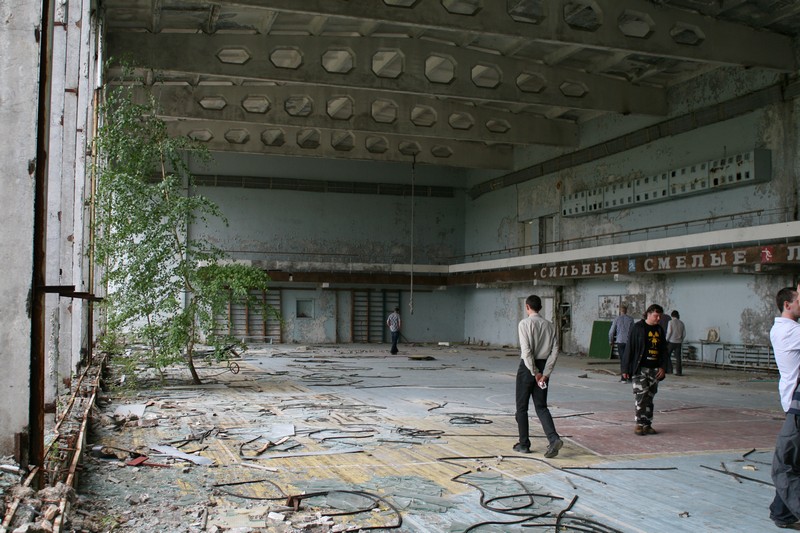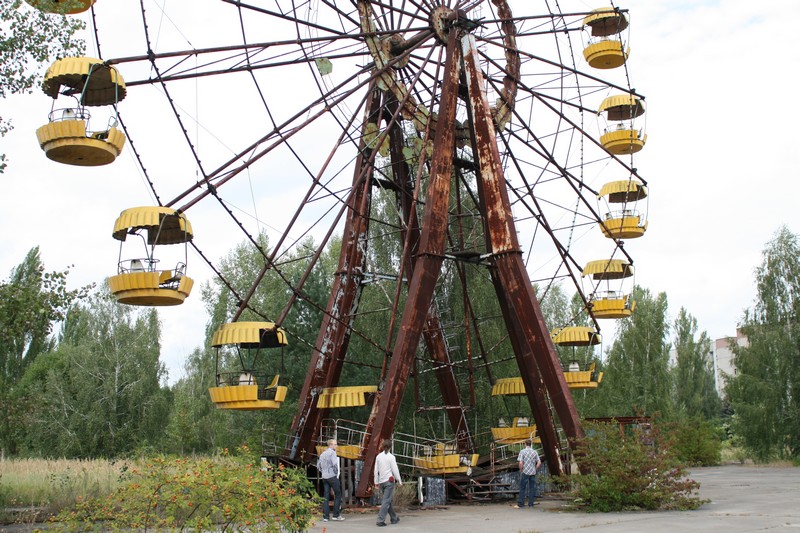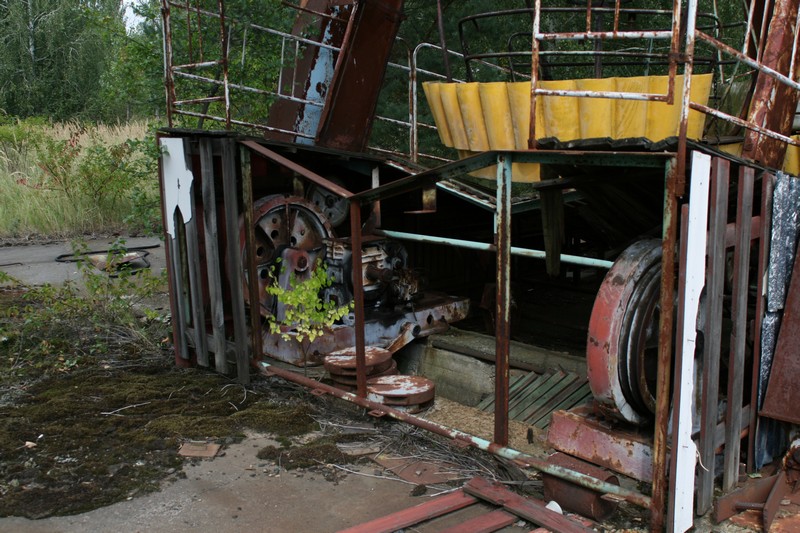After a 2 hour bus ride from Kiev, we arrived at the 30km exclusion zone checkpoint.

“Please will everyone get out and bring your passports”
The guard has a clipboard with our names and passport numbers on, I hand mine over.
He runs his fingers down the list of names, looks puzzled, runs his finger down the list of numbers to check and is even more confused, he consults the driver in Russian.
“The numbers don’t match” translates a Belgian guy also on the tour.
Shit, I gave them the number of my other passport (I have two UK passports), visions of being left outside the checkpoint while the group saunters on cross my mind.
Eventually after much incomprehensible discussion the guard shrugs his shoulders and lets us through.
We stop in a nearby village and pick up our tour guide, who is also a leading government official concerned with public relations in regards to Chernobyl.

As you can see his approach is somewhat.. relaxed to the whole affair.

This monument was built and maintained by local firefighters with no outside assistance in order to commemorate their comrades who died.

Reactor number five was under construction at the time of the disaster; the cranes used for its construction remain a skeletal monument to the confidence and visions of expansion at the time.
As our tour guide explained, the party line on nuclear disaster before 1986 was “It can never happen” and afterwards the party line was “It can never happen even more“.

A quick demonstration of the geiger counter reveals that in the air the count is around 45 miliroentgen per hour.

On the ground it’s over 200!

The biggest surprise for me was seeing people walking around!
Apparently around 10,000 people work on a shift rota of something like 14 days on, 50 days off to minimise the build of up radiation in their bodies, and at any one time around 3,000 people are working in the exclusion zone.

The information centre had an amazingly detailed model of the current state of reactor #4.
Apparently the thing in the middle of the photo that looks like a scrubbing brush weighing 30 metric tonnes leapt 10 metres in the air at the time of the explosion and landed on its side… Gives you some idea of the scale…

We got very close to reactor #4 (by my standards anyway) and this was in fact the area in which we saw the most people.
They didn’t say what the radiation level was where we were standing and nobody asked.

Town sign for Pripyat.

The long road to Pripyat.

The infamous bridge from which the Pripyat villagers watched the technicolour fireworks display that was the burning reactor #4, fifteen minutes here at the time was a lethal dose.

Pripyat main street, you can’t even see all the buildings; it feels not so much like a city with trees in it as a forest with buildings in it.

Entrance to Pripyat hotel.

What remains of the lobby.

“In case of nuclear disaster, please do not use the elevator”
So we took the stairs!

I think I’ll stick with my Hostel…

The views however are quite spectacular.

This was my favourite place of the whole trip, I have absolutely no idea what this tree is growing in six storeys above ground level, but I’m very glad that it is.

Outside the hotel again there’s evidence still of the group of graffiti artists posing as photographers who paid Pripyat a visit some years ago. Though caught they were not prosecuted as the entire town is classified as nuclear waste, and there isn’t a law against graffitiing nuclear waste!

More graffiti, I’m not quite sure how I feel about it, I think if anything it adds a chilling air to a place that, given the style of the locals, is more exciting than reverential.

The stairs leading up to the local gym.

The climbing rope hangs forlornly, the last remnant of what must have been a well furnished gym at the time (Pripyat was a model town for the communist ideal)

An amazingly photogenic place, you could spend weeks here with an army of creative photographers without realising anything like its full potential.

From the inside of the gym you can see our next stop, the amusement park that was due to be opened a few weeks after the disaster.

Bumper cars sit gently rusting, never having heard the playful whoops of children in their midst.

Somehow I don’t think this would pass Health and Safety…

The ferris wheel was one of the few rides that was used briefly even though the park was never officially opened, its belts long rotted the engine turns no more.

“Anyone want to take a dive?” jokes our guide.

Maybe not…
The olympic sized swimming pool was apparently quite a popular social ground at the time.

Entrance to the local school.

And entire room, filled 3 foot deep with strewn books, a pity you can’t take souvenirs…

Rusting cash machine.

This abacus looks rather folorn sitting forgotten in a corner, its wires bent, its beads spent.
The school was the end of the tour, we nearly ended up not visiting it until one of the tourists shouted out on the way back to Kiev “We must visit the school”
I’m glad we did.